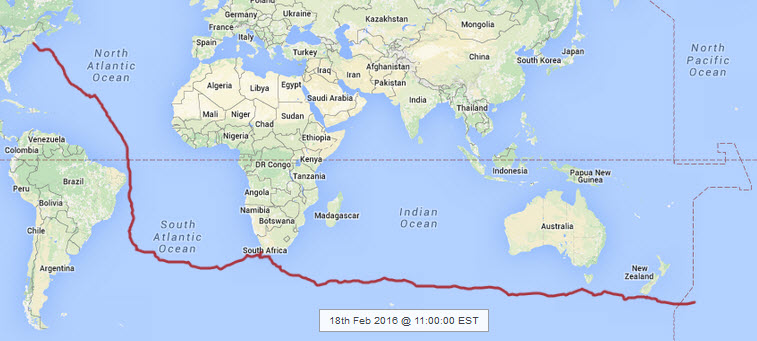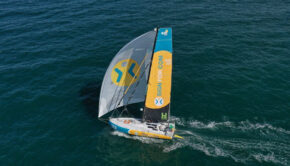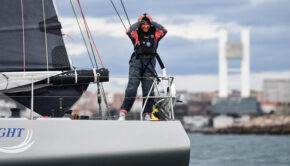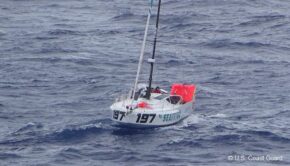Joe Harris: Aiming at Cape Horn
Published on February 20th, 2016
Aboard his Class40 GryphonSolo2, American Joe Harris departed Newport (RI) on November 15 in a bid to break the 40 Foot Monohull Solo Non-Stop Round the World Record. That plan, however, got derailed when a stop in Cape Town was needed for repairs to his energy systems. Here’s an update from Joe on February 20…
Following a slow start after rounding Stewart Island at the southern tip of New Zealand on Sunday (Feb 14), it has been fast and rough sailing since Wednesday (Feb 17), and GS2 has been racking up the miles.
The wind has been consistently from the N- NW so that means it is coming directly from our left (port) side on a beam reach, or approximately 90-100 degree True Wind Angle between the boat and the wind.
The seas generally stack up in the same direction as the wind, and grow bigger as the wind grows stronger. The past 3 days of 20-35 knot winds, with the rolling seas of 15′ – cresting and breaking – have seen a ton of cold water over the boat and through the cockpit. So if I am working on deck, I have to be very aware of the waves so as not to get swept into something and get injured or go overboard.
The reality is that I am not required to be on deck that much, as my sail plan of 3 reefs in the mainsail and the staysail has remained the same for 3 days. I do make deck tours at least 3 times a day to check for chafe on the lines and sails, and inevitably get soaked, but can then come below to dry off and warm up.
My goals in these kind of strong wind and sea conditions are as follows:
1.) Try to make better than 200 miles per day – but with a defensive mind-set – to avoid trouble and not be overly aggressive with the sail plan.
2.) Try not to break anything, tear any sails or get injured – avoid knock-downs from having too much sail up and being rolled by wind and waves.
3.) Stay well-rested and well-fed so I can be physically strong and mentally sharp – to make good decisions and respond quickly in pressure situations.
4.) Conserve diesel fuel by relying entirely on my solar panels and hydro-generator as the boat is moving quickly through the water.
5.) Tactically, stay far enough north to be clear of icebergs and stay far enough south to avoid high pressure systems and areas of calm. I’m currently sailing in the band from 47 South to 50 South longitude.
6.) Keep busy to avoid boredom and malaise.
Utilizing these basic strategies, I can simplify life and try to relax down below in the cabin, although I do feel cooped up in the bad weather and have to get out periodically. Being able to communicate by email with friends and family is huge and provides a great relief from the 24/7 task of piloting this small vessel over a vast and remote ocean.
When the wind finally lets up (looks like that will happen tomorrow) I can clean up and dry out the boat – make water, which is difficult to do in rough conditions – and re-organize sails, food and clothing. Then get ready for another cold front arriving on Sunday (Feb 21) and strong winds and big seas for the foreseeable future. That is sailing in the Southern Ocean.
No mistakes – playing defense – aiming at Cape Horn.
Background: As a result of Joe’s 11-day detour to Cape Town (Dec 28-Jan 8), Joe will no longer be able to officially break the existing non-stop record of 137 days, 20 hours, 01 minute, 57 seconds – set by Chinese sailor Guo Chuan in 2013. However, he remains hopeful to unofficially better the mark. Website: www.gryphonsolo2.com










 We’ll keep your information safe.
We’ll keep your information safe.